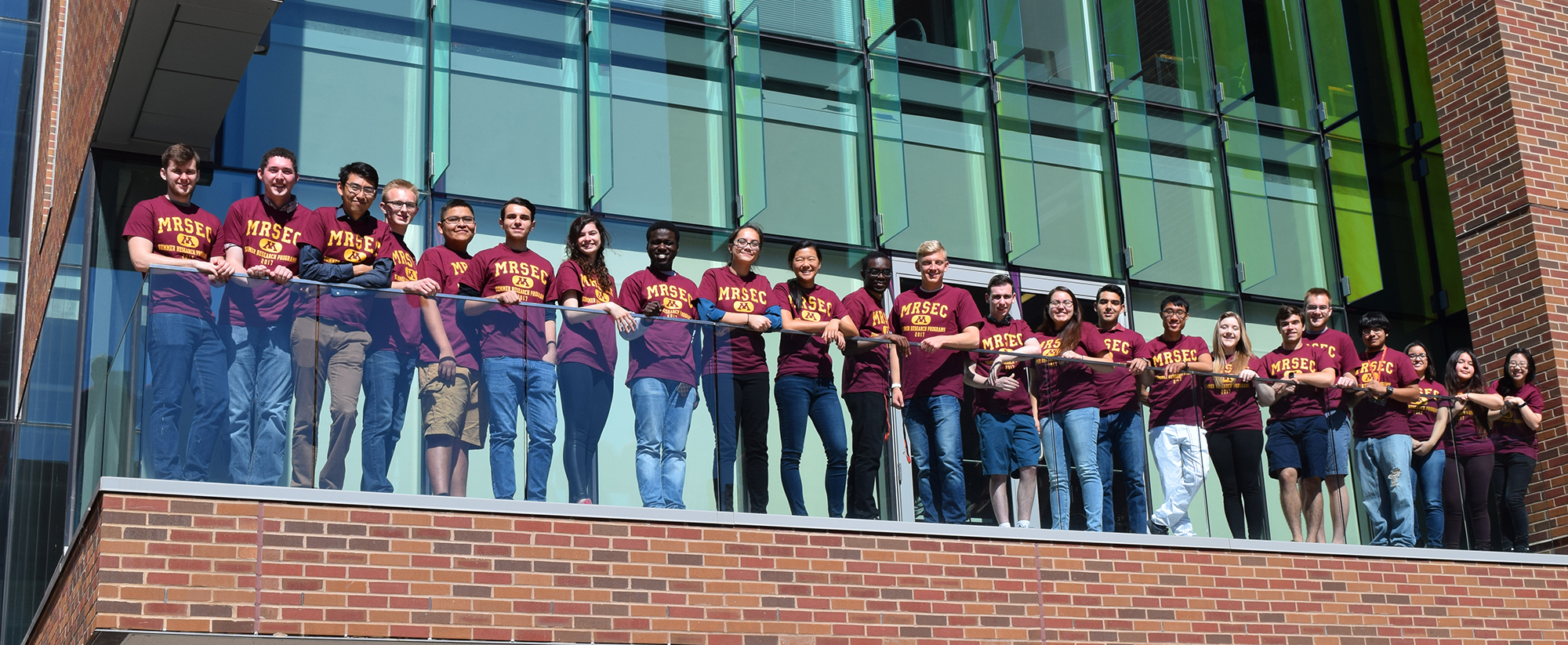
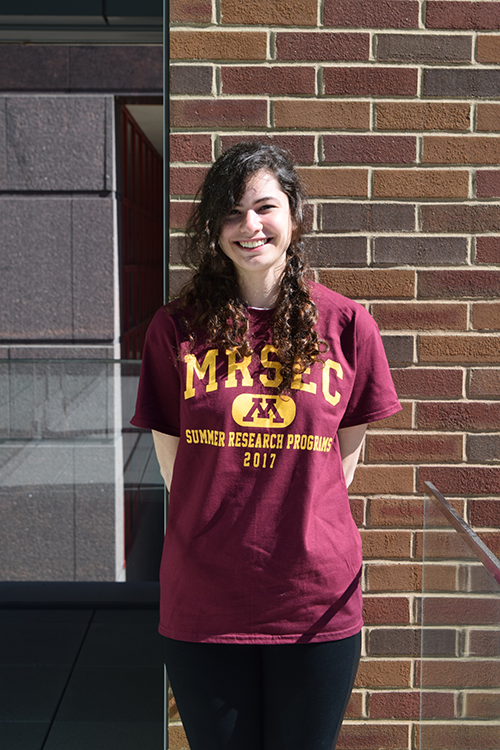
Home Institution: Loyola University Chicago
REU Mentor: Dan Frisbie
Fabrication of Larger-Sized Transistors Using Self-Aligned
Printed electronics show promise for cost savings in large-area applications such as televisions and solar panels because printing is an additive process. Expensive materials are only printed where they are needed in the device unlike traditional photolithographic methods where material is coated over the entirety of the device and then removed where it is not needed. A drawback of printed electronics is the poor resolution, limiting practical feature sizes to the order of 20 micrometers. To improve upon this limit, a novel technique has been developed called self-aligned capillarity-assisted lithography for electronics (SCALE). The SCALE process utilizes imprint lithography to mold a series of reservoirs linked to capillary channels into a UV curable polymer. Electronic inks are easily printed into relatively larger (10’s-100’s of μm) reservoirs where they flow along the capillary channel to their feature. Channels are engineered at different levels in order to properly inkjet-print the necessary materials into a multilayered device. Feature sizes on the micron and sub-micron scale have already been successfully produced; however, I will be using the SCALE process to engineer large millimeter sized features for transistors that serve as a demonstration to high school students. This technique allows for easy device fabrication with which students can recognize all the components of a transistor and how they work to power the device. Understanding the device's functionality will be done through monitoring changes in resistivity and semiconductor color.

Home Institution: Utah State University
REU Mentor: Vlad Pribiag
Assistance with Fabrication and Analysis of InSb Nanowires for Use in Low Temperature Experiments
The future looks very bright for the field of solid state physics because it involves the attempt at understanding the fundamentals of how semiconductors behave in special circumstances at the nanoscale. Thus, we turn to microfabrication processes and lithography, where micro-devices can be put together by means of etching and filling of substrate material over layers upon layers of wafer. We use equipment in the laboratory such as the AFM, Profilometer, and Keyence Digital Microscope to monitor the Reactive Ion Etching Process of an HSQ covered sample. When the processes are determined to be in the right conditions after etching, semiconductor nanowires can then be added to a sample for the planarization step. The planarization of the layer can then allow the nanowires to be contacted with ferromagnetic materials in which are then applicable to nanoscale machines and devices for research. More specifically, the project comprises of devices based on InSb nanowires, Si nanoparticles and InAs-based quantumwells.

Home Institution: University of Minnesota Twin Citites
REU Mentor: Paul Dauenhauer
Construction and Verification of an Automated Microcatalytic Reactor's Accuracy Using Solid Acid Catalysts
Microreactors have made great improvements in reaction engineering research due to their ability to rapidly screen catalysts of interest for any desired chemistry. Evaluating the performance of a catalyst for a given chemical reaction usually requires a well-trained chemical engineer to continuously run and monitor multiple reactions in order to collect enough data to determine a certain reaction’s properties. The development of an automated microcatalytic reactor could significantly decrease the amount of manual labor and intensive training required to evaluate new catalysts for reactions, which do not have well known chemistries.
The automated microcatalytic reactor was housed within a gas chromatograph (GC), in which the GC inlet contained the reactor and an automated liquid sampler (ALS) was used to deliver the reactant. The reactor is a semi-continuous flow reactor with the ability to reach steady-state, inject the results, and quickly move on to new conditions. Once constructed, the automated microcatalytic reactor’s ability to obtain accurate data was tested by running reactions with well-known chemistries, such as alcohol dehydration over solid acid catalysts. This was performed by comparing reaction rates, activation energies, and product selectivity to those in the literature. This validation starts to give the automated microcatalytic reactor the ability to potentially be standardized and be used in more diverse labs.
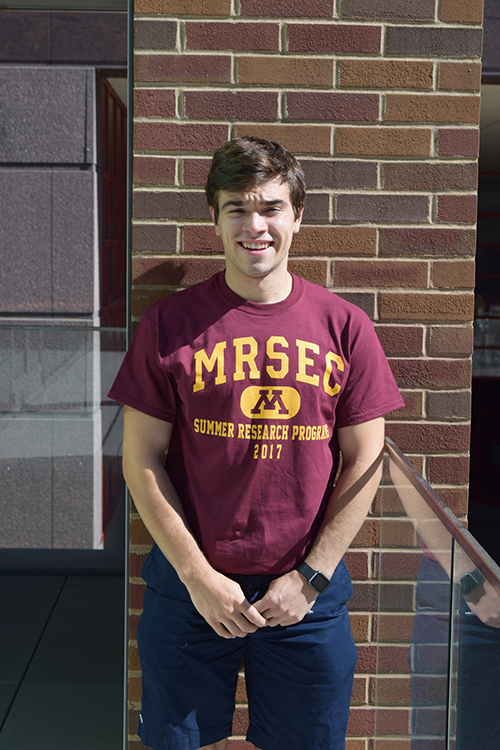
Home Institution: Georgetown College
REU Mentor: Jeff Derby
Analysis of Bridgman Growth of Scintillator Crystals
The work will render the modeling results for the design work for a five-heating-zone vertical Bridgman furnace, which is used for the crystal growth process of BaBrCl. CrysMAS (a code developed by the Crystal Growth Laboratory at Fraunhofer IISB) is employed to model global heat transfer in the furnace. The preliminary results would highlight the differences in the growth characteristics of various furnace designs. The Crystal Growth Laboratory led by Edith Bourret-Courchesne in Lawrence Berkeley National Laboratory (LBNL) has achieved notable success in the discovery of new scintillator crystals [1]. The next step towards utilization is to produce these scintillator crystals with higher quality. Heat transfer modeling is used to optimize the design of the furnace and the strategies to control the heating zones. Crystal growth modeling is performed to improve the solid-melt interface shape and reduce the thermal stress in these new scintillator crystals that would result in cracking, one issue that hinders the growth of large-size crystals. These models would also be used to promote the design of the furnace to focus on the most important phenomena that affects crystal growth processes. Our work would allow cheaper, more efficient scintillator crystals to be produced.
[1] Bourret-Courchesne, E. D., Bizarri, G. A., Borade, R., Gundiah, G., Samulon, E. C., Yan, Z., & Derenzo, S. E. (2012). Crystal growth and characterization of alkali-earth halide scintillators. Journal of Crystal Growth, 352(1), 78–83.
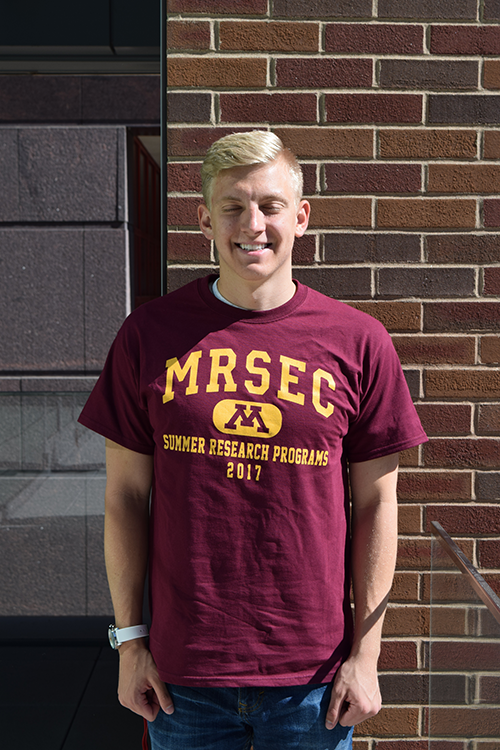
Home Institution: University of Wisconsin-Green Bay
REU Mentor: Frank Bates
Effects of Crosslinking PB-PLA Diblock Copolymers
Diblock copolymers are the covalently linked composition of two different polymers. Studying these is useful to understand structure-property relationships in soft matter. Asymmetric AB diblock copolymers (ƒA << 0.5) easily order into particle-forming structures; the most common is cubic symmetry (BCC lattice). The purpose of this project was to understand the role of chain exchange in model poly(1,2-butadiene)-b-poly((±)-lactide) (PB-PLA) diblock copolymers through synthesis and characterization. To do this, PB-PLA diblock copolymers were synthesized using sequential anionic polymerization followed by a ring-opening polymerization technique. 1H Nuclear Resonance Spectroscopy, Size Exclusion Chromatography, and Differential Scanning Calorimetry were used to quantify the molecular characteristics of the samples. Additionally, the physical characteristics were analyzed via X-ray scattering and rheology. The PB cores were crosslinked by adding a small amount of photo-initiator (< 1 wt%) and activated by UV light. The physical properties were examined during and after crosslinking to note the structural changes in the sample. We hypothesized the crosslinking will eliminate or decrease chain exchange, thus increasing the order-disorder temperature (ODT) and possibly the morphology. This research will provide fundamental information about the physical effects of chain exchange in diblock copolymers, specifically regarding ordered structures and fluctuations in the disordered state.
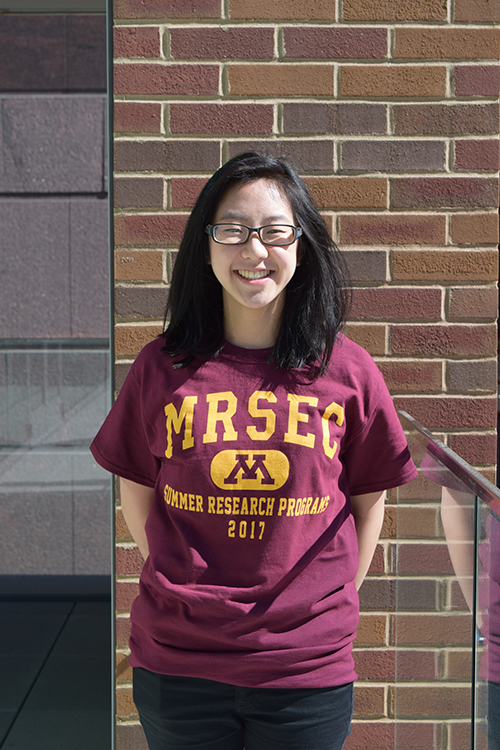
Home Institution: Case Western Reserve University
REU Mentor: Uwe Kortshagen
Lifetime of Silicon Nanocrystals in Optoelectronics
Silicon nanocrystals (Si NCs) have the potential to change the field of optoelectronics because of silicon's abundance and non-toxicity as well as our ability to customize the material's photoelectric behavior for its intended applications, such as solar cells and light emitting diodes (LEDs). For example, Si NCs can improve the efficiency of solar cells and LEDs because we can control the way these devices absorb and emit energy by changing the NC particle size. To change the NC size during the plasma reactor synthesis process, we varied the residence time of the NCs in the plasma chamber. We then conducted time resolved photoluminescence tests to measure the lifetime of Si NCs across the emission spectrum and to better understand factors that impact PL lifetime. Some factors we investigated included the oxidation and sintering of Si NCs. Since oxidation reduces particle size, we also examined the size effects of NCs on PL lifetime. We found a direct correlation between the size of the NCs and their lifetime: the lifetime decreased with decreasing Si NC size. On the other hand, sintering the NCs had very little effect on the PL lifetime of the material, possibly resulting from oxidation or negligible facet sizes.
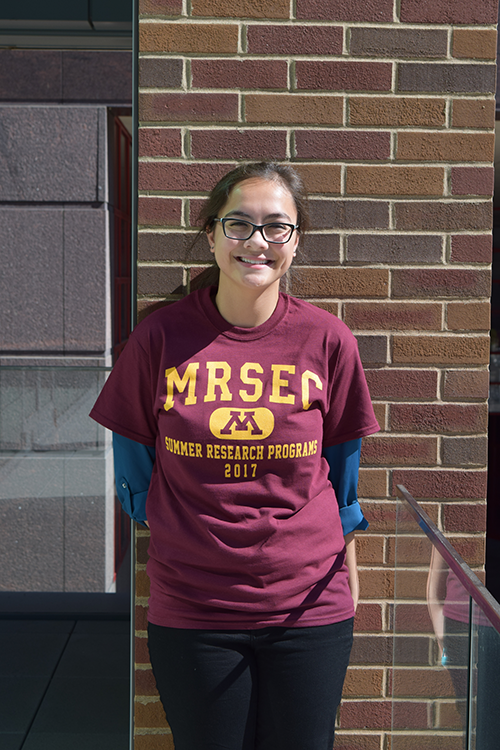
Home Institution: Rowan University
REU Mentor: Uwe Kortshagen
Exciton Recombination in Silicon Nanocrystal Films and Solutions
Excitons in nanocrystal semiconductors have become of interest for their industrial applications, ranging from light-emitting diodes (LEDs) to solar panels and photodetectors. This interest has led to the need for better understanding of how excitons are transported in silicon quantum dot (QD) films and solutions. We use Time-Resolved Emission Spectroscopy (TRES) to measure the photoemission from the sample in terms of time and emission energy. This exhibits the radiative decay of the excitons in the sample. Gold nanoparticles, which serve as non-radiative exciton traps, were added to QDs in solution. Exciton diffusion can be studied by observing the changes in photoluminescence (PL) lifetime in film, which was shown to decrease as concentration of gold increases. By adding gold, the volume available for radiative exciton recombination decreases. In addition to looking at excitons in QD films, we also observe the radiative decay of excitons in the QD samples in solution. In contrast with previous studies, a redshift was observed in QD solution samples, of comparable size to the redshift expected and seen in QD film samples. This is hypothesized to be caused by a wide size distribution of non-interacting particles, though further study is needed to support this theory.

Home Institution: University of Texas Rio Grande Valley
REU Mentor: Chris Leighton
Influence of particle size and stoichiometry on the magneto-electronic properties of La1-xSrxCoO3 nanoparticles
Perovskite oxides have been shown to exhibit a plethora of interesting and important materials properties, ranging from high temperature superconductivity, colossal magnetoresistance, and ferroelectricity, to co-incident metal-insulator, structural, and magnetic phase transitions. Perovskite cobaltites doped with alkaline-earth metals, such as La1-xSrxCoO3, have shown a clear form of magneto-electronic phase separation which is heavily influenced by stoichiometry. In addition to chemical composition effects, magneto-electronic phase separation behavior could also be affected by constraining dimensionality of the material. To study this behavior, nanoparticles of La1-xSrxCoO3 are being studied here as a function of composition and particle size. Magnetometry measurements on La1-xSrxCoO3 (xnom = 0, 0.05, 0.1, 0.2, 0.3) nanoparticles from year-old samples and recently-made samples were first studied and compared to analyses made a year ago. This was done to determine if there was any deterioration in the magnetic properties of the nanoparticles, and to see how particle size affects these properties. Preliminary analysis demonstrates that there is little decay of the magnetic properties with time. Scanning electron microscopy shows that the new samples have slightly smaller particles on average and the size distributions are significantly narrower. Energy dispersive analysis of x-rays (EDAX) proves that both sample batches were strontium deficient while having a high degree of polydispersity of strontium concentration. The old samples also contained chlorine and potassium contamination. Overall, this analysis demonstrates an improvement in the synthesis procedure used to make the nanoparticles. Further work will focus on EDAX mapping to clarify the polydispersity of the nanoparticles. Additionally, x-ray diffraction will be used to confirm the phases of the samples

Home Institution: St. Catherine University
REU Mentor: Eray Aydil
Synthesis and Characterization of Two-Dimensional SnS Nanoparticles
Layered metal chalcogenides are emerging as two-dimensional (2D) materials with a wide range of electronic, optical, chemical, mechanical and catalytic properties dependent on thickness. Like graphene, tin sulfide (SnS) may be separated to form single or few layer nanosheets. SnS is promising because of its high theoretical efficiency at converting light into energy of 24% comparable to silicon, abundance in nature, and non-toxicity. The overall goal for this research was to synthesize high purity single or few layer tin monosulfide via a green hydrothermal synthesis. Specifically, we discuss strategies to control growth production of nanosheets with large lateral dimensions (> 1 micron) by controlling for post synthesis parameters. Three different things were tested out when optimizing the synthesis; solvent type, time dependence, and sonication methods. First by looking at the morphologies of two different solvents; water and ethylene glycol. Time dependence was measured by synthesis from 4-24 hours in the hydrothermal bomb. Then sonication was used to exfoliate the material into thin sheets. The resulting nanosheets were characterized by XRD, SEM, AFM, TEM, Raman, and UV-visible spectroscopy. The water synthesis was observed to yield large (several micron) nanoplates with the abundant side product of tin oxide. The synthesis using ethylene glycol as the solvent was observed to create flower-like nanoflowers with very different morphologies than water, and without any tin oxide side product. The time dependence observation was that the growth of the nanoparticles in water is a stacking of the plates while the growth of the nanoparticles in ethylene glycol was a more defined surface structure of the aggregated plates into a nanoflower like structure. Sonication methods were successful in exfoliating the nanoparticles into a (>1 micron) single layer. These findings are significant in the continued optimization of a 2-D SnS synthesis that can be scaled up.
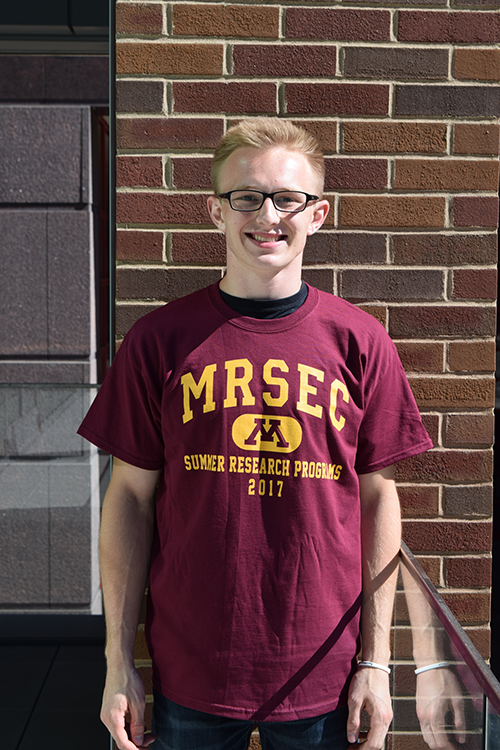
Home Institution: University of St. Thomas
REU Mentor: Michael McAlpine
3D Printing Silicon Nanocrystal Light Emitting Diodes
Bulk silicon crystals do not typically luminesce because of bulk silicon’s intrinsic narrow indirect band gap; this engenders silicon’s semiconducting properties. However, as the diameter of silicon crystals approaches the nanoscale, quantum confinement effects take affect—quantum confinement effects occur when a material’s diameter approaches the de Broglie wavelength of the electron’s wave function. As the diameter of a semiconductor approaches the electron-hole pair radius (also known as the Bohr radius), the orbital overlap of the atoms composing the nanocrystal decreases, which creates discrete energy levels and consequently increases the energy needed for an electron to move to the conduction band from the valence band. By injecting holes and electrons into silicon nanocrystals (SiNCs), exploitation of the expanded band gap may transpire and will result in the emission of light with a wavelength that is dependent on the size of the nanocrystal. The tunability of SiNCs is an advantageous property when considering materials needed to create solid-state lighting devices. Through the utilization of 3D printing, a new avenue is created for fabricating solid-state lighting, like light emitting diodes (LEDs). This approach will expand the range of functional materials that 3D printers are capable of extruding. Examples of the types materials used in this printing process are, but not limited to: (1) liquid and solid metal electrodes, (2) conductive organic polymers, (3) emissive inorganic quantum dots, and (4) silicon based substrates for printing on top of. By fabricating LEDs via 3D printing, novel three dimensional designs incorporating LEDs, that are not typically accessible by microfabrication techniques, become conceivable.

Home Institution: Drake University
REU Mentor: Marc Hillmyer
Transamidation of Activated Polyacrylamide Via Destabilization of Amidic Resonance
Transamidation is of major interest in organic synthesis. However, this reaction is difficult to perform under mild conditions due to the high stability of the amide bond through amidic resonance. We seek to assess the effect of using tert-butyloxycarbonyl (BOC) groups to weaken the amidic bond stability and thus increase its reactivity in transamidation reactions. This strategy is known in small molecule chemistry, but has yet to be applied to polymer chemistry. First, we synthesized a highly activated monomer from commercially available acrylamide, and polymerized it to form a polymer with weakened amidic resonance. This polymer was then tested in individual transamidation reactions with a variety of amines that range in nucleophilicity. The resulting polymers were characterized by 1H-NMR, 13C-NMR, SEC, TGA, and DSC. Overall, we observed that, because of the weakened amide bond, these reactions successfully produced their respective, transamidated polymer products with full conversion in mild conditions. This method of transamidation provides a more accessible route for generating polymers that would be otherwise difficult or impossible to generate through radical polymerization alone. Thus, this strategy opens the door to the synthesis of unique and novel acrylamide-based polymers with an extensive variety of functional uses, real-world application, and further potential benefits in materials such as copolymers, block polymers, and hydrogels.
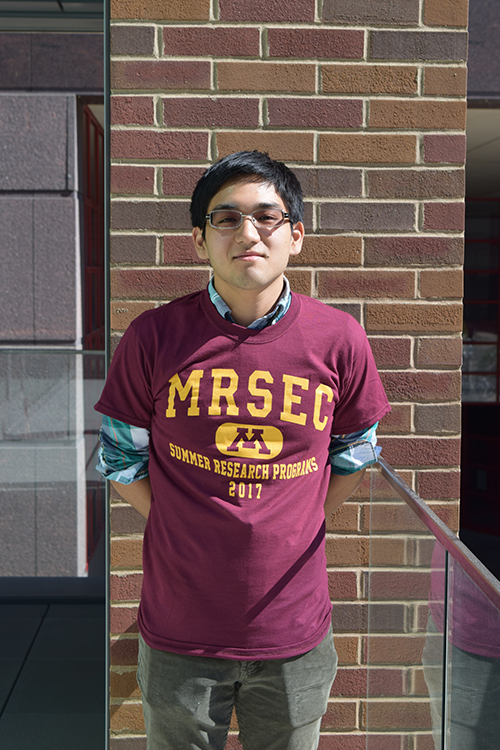
Home Institution: University of Texas Rio Grande Valley
REU Mentor: Tim Lodge
High modulus and Conductivity Polymer Electrolyte Membranes
Polymer electrolyte membranes (PEMs) with mechanical robustness and high ionic conductivity at room temperature are vital components of next-generation lithium-ion batteries. PEMs were produced via polymerization-induced microphase separation (PIMS) facilitating long-range continuous conducting nanochannels, and a cross-linked mechanical phase. The design of PEMs involves the growth of cross-linked polystyrene phase off poly[oligo(ethylene glycol) methy ether acrylate] (POEGA). During the reaction, lithium salt, lithium bis(trifluoromethanesulfonyl)imide (LiTFSI), and succinonitrile (SN), a plasticizer partitions to the POEGA phase to form the conducting domain, while a glassy polystyrene (PS) phase provides the mechanical stability to the PEMs. The addition of SN as a plasticizer increases the ionic conductivity and permits the miscibility of styrene/divinylbenzene monomers with POEGA and lithium salt. The current work will utilize POEGA at various molecular weights, variations concentrations of lithium salt and SN to simultaneously optimize the ionic conductivity and mechanical properties. The resultant PIMS PEMs will be tested and measured for its ion conductivity at different temperatures using an AC impedance spectroscopy, mechanical properties by a tensile bar loaded to obtain elastic tensile modulus at different temperature ranges, observe morphology by small-angle x-ray scattering(SAXS) imaging & transmission electron microscopy (TEM), and its thermal stability using a thermogravimetric analysis under nitrogen atmosphere. The system developed will help in the understanding and advancement of Lithium-ion batteries.
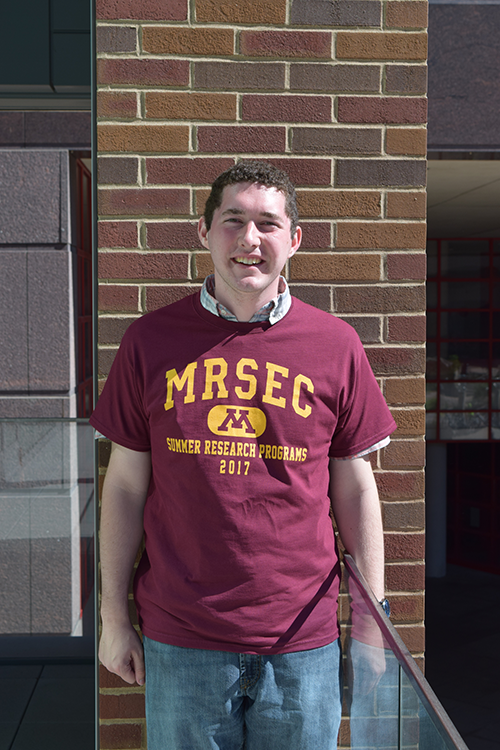
Home Institution: Louisiana Tech University
REU Mentor: James Johns
Growth of Single to Few Layer Black Phosphorus
Black phosphorous is a Van der Waals material and an allotrope of phosphorous with properties useful for electronics, including a layer dependent band gap, a high charge mobility, and chemical stability. One of the problems with black phosphorous is that all known techniques to manufacture few layer black phosphorus are “top down” approaches, including exfoliation of bulk black phosphorous. The limitations of exfoliation are that the orientation of an exfoliated black phosphorous grain is random, the thickness of the exfoliated film is not consistent or controllable, and the size of the film created is limited. We attempted two methods to grow few layer black phosphorus in a more useful bottom up approach. The first method included sublimating bulk black phosphorous in a physical vapor transport furnace and depositing the vapor downstream. The second method was to raise the temperature of molten tin with black phosphorus, which was inspired by a growth mechanism hypothesis stating that phosphorous and tin form a eutectic alloy at high temperatures, and then, as the mixture cools, black phosphorous precipitates out of this alloy.

Home Institution: Utah State University
REU Mentor: Sarah Swisher
Optimization of parameters for Zinc Oxide thin film synthesis for semiconductor application
ZnO thin films has potential as a multifunctional material to applied in PH sensors, surface acoustic wave devices, optical waveguides, solar cells, biosensors, etc. ZnO can be manufactured utilizing low-cost wet processing methods that include electrochemical, chemical bath, and sol-gel spin coating practices. The solution based deposition processes provides a cheap and basic production route for depositing ZnO layers because there is no need for vapor deposition equipment. Although the sol-gel method is a simple technique, many factors affect the quality of the ZnO film such as precursor concentration, pre-heating temperature, sol aging temperature, coating speed, etc. The effects of ‘precursor concentration, sol-aging time, and spin speed will be examined for their effects on film quality. Characterizations will include XPS to clarify chemical composition, UV visible transmission spectroscopy to determine film absorption, XRD to examine crystallinity. Due to stabilization of the solution as the sol ages, it is expected to see Zinc oxide increase compared to Zinc Hydroxide. The average thickness of films decreases with increases in spinning speed.
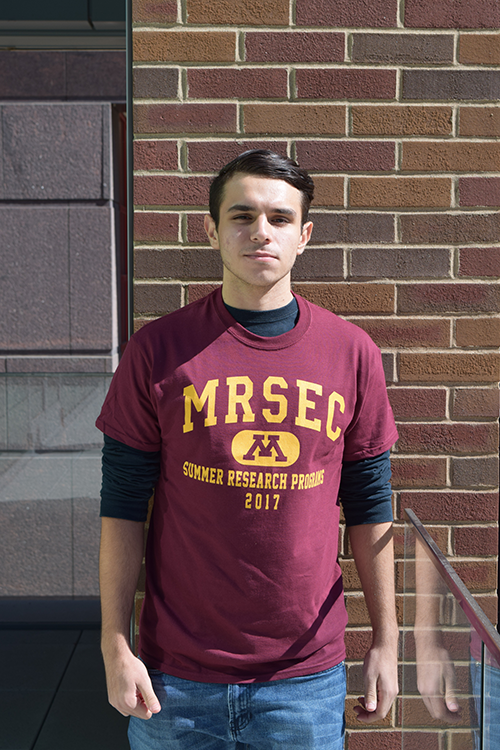
Home Institution: University of Puerto Rico Humacao
REU Mentor: Bharat Jalan
Electronic transport behavior in BaSnO3 and NdTiO3 thin films grown using hybrid molecular beam epitaxy
Complex oxides with perovskite structure are in the focus of research because they exhibit impressive multifunctionality such as high temperature superconductivity, colossal magnetoresistance and multiferroicity. Barium stannate (BaSnO3) has a cubic perovskite structure with a wide band gap of ~ 3 eV and is optically transparent. Recently, it has been shown to possess high room-temperature electron mobility. This makes it an impressive material for potential room-temperature applications including transparent conductors. My research focused on the growth of epitaxial, single-crystalline BaSnO3 films grown on various substrates using hybrid molecular beam epitaxy (MBE) approach. Films were characterized using x-ray diffraction (XRD), grazing incidence x-ray reflection (GIXR), and atomic force microscopy (AFM). Electronic properties were measured using physical properties measurement system (PPMS) where I studied the temperature dependence of resistivity. Temperature dependent data was analyzed to study the governing transport mechanisms at different temperatures for stoichiometric as well as non-stoichiometric films. Furthermore, neodymium titanate (NdTiO3) films were grown using the same hybrid MBE approach. NdTiO3 has an orthorhombic perovskite structure and is an antiferromagnetic Mott-insulator with a Mott-Hubbard gap of 0.8 eV. Recently, it has been shown that NdTiO3/ SrTiO3 forms two-dimensional electron gas (2DEG) at the polar/nonpolar interface. This makes it a promising material for understanding the longstanding issues concerning the true characteristics of the polar discontinuity at oxide heterojunctions. My research focused on exploring the electrostatic gating on NdTiO3 films. The properties were measured using PPMS.
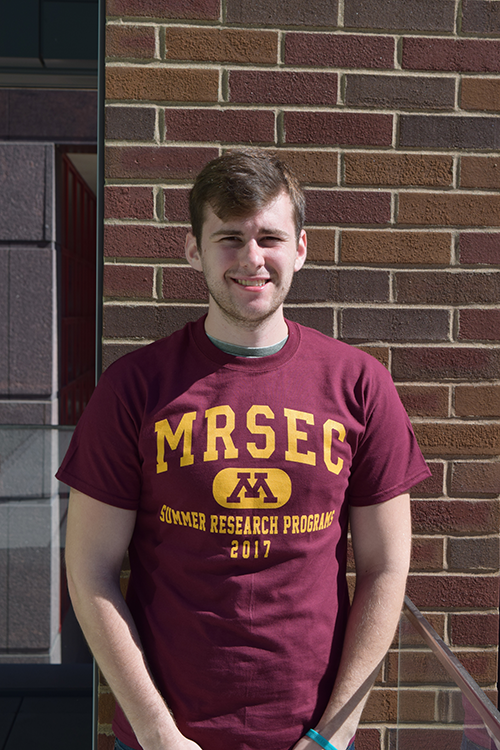
Home Institution: University of Michigan
REU Mentor: Cari Dutcher
Effects of pH on Bentonite-Humic Acid Flocculation
Polymer flocculation is commonly utilized to remove colloidal particulates in solution. Flocculation (floc) performance depends on several solution properties such as pH, ionic strength, and natural organic material (NOM) content. Traditional flocculation experiments, known as jar tests, were conducted at pH levels of 3 to 11 and a range of polymer dosages to determine the flocculation efficiency by measuring turbidity. Internal floc structure was characterized using laser confocal microscopy. Fluorescently-tagged polymer flocs were imaged with laser confocal microscopy to determine internal floc structure. Not only does bentonite aggregate morphology change as a function of pH, but also humic acid charge density changes, which impacts the flocculation behavior. Flocculation performance of the bentonite-humic acid system differs strikingly from the bentonite only system. Competitive flocculation of bentonite and humic acid worsens flocculation performance with increasing solution pH.

Home Institution: Tuskegee University
REU Mentor: Christy Haynes
Nanotoxicity Evaluation Of Doped Silicon Nanocrystals
Doped silicon nanocrystals (DSNcs) have demonstrated their biocompatibility and various applications compared to their alternatives quantum dots containing heavy metal content, and have drawn the attention of researchers as a result of its potential application in sensing, bio imaging, and energy conversion. Shewanella oneidensis MR-1 (S.oneidensis MR-1) is commonly used as the model microorganism in studying the nanomaterial toxicity of silver nanoparticles (Ag NPs), gold nanoparticle (Au NPs), and Li-ion battery materials. We synthesized NCs doped in boron and phosphorus of various concentration attempting to assess the bacterial toxicity in S.oneidensis MR-1. The bacterial toxicity was determined using the colony counting assay (drop plate method) which includes a 10-fold serial dilution to assess toxicity using quantitative analysis.

Home Institution: University of Missouri Columbia
REU Mentor: Andre Mkhoyan
Infilling of Nanocrystal Networks Using (Plasma-Enhanced) Atomic Layer Deposition
Development and implementation of photodetection, photovoltaic, and photocatalysis technologies in the past decades have driven demand for transparent conductive substrates to an all-time high, with indium tin-oxide (ITO) glass being the substrate of choice. Though ITO glass boasts superior conductivity and transparency with respect to alternatives, indium production is dependent on zinc-sulfide ore mining, making production of ITO glass an expensive and environmentally-taxing endeavor. In searching for viable alternatives, we demonstrate the use of atomic layer deposition (ALD) and plasma-enhanced atomic layer deposition (PEALD) in infilling porous nanocrystal networks as an efficient and cost-effective method to synthesize metamaterials with desirable electrical and optical properties. By infilling ZnO with TiN using PEALD, we achieve a conductive, plasmonic material that absorbs strongly in the infrared region of the electromagnetic spectrum, allowing for possible applications in photodetection devices, photocatalysis, and photovoltaic energy conversion. Using ALD, we infill ZnO nanocrystals sequentially with further ZnO, followed by Al2O3, creating a robust, highly interconnected nanocrystal network, useful for physics studies of the insulator-metal transition in such networks. By comparing uniformity of elemental distribution throughout the thin films and their capacity to achieve desired properties, we discuss the potential and the limitations of ALD and PEALD as a nanocrystal network infilling technique.
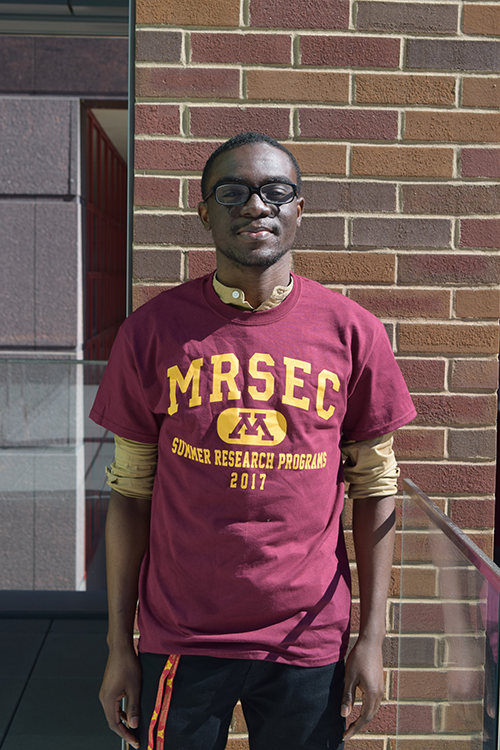
Home Institution: Iowa State University
REU Mentor: Kevin Dorfman/ David Morse
Generation of Complex Morphologies in Diblock, Copolymers via blending using Self Consistent Field Theory (SCFT)
The combination of polymers to a single material can be done in different ways. These combination can lead to different phase behaviors. In recent years, Self-consistent field theory (SCFT) a powerful tool for the designing and interpretation of experiments on phase behavior of block polymer has been used to study and predict different morphologies of polymer blends. SCFT determines face behaviors by analyzing how the configuration of a test polymer chain is affected by the presence of other chains and vice versa. In this research a numerical implementation of SCFT known as Polymer Self Consistent Field (PSCF) is used to calculate phase diagrams of block copolymer by comparing free energies of competing ordered phase.The numerical evaluation of the different phases of block copolymer directly influences the physical properties and applications of polymers.
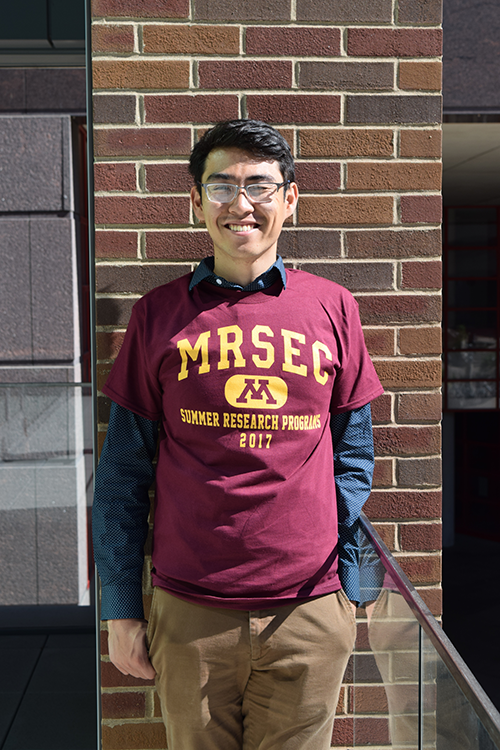
Home Institution: University of Puget Sound
REU Mentor: Russ Holmes
Mixing Lead Free Tin and Strontium Halide Perovskites for Solar Cells
The term “perovskite” denotes a broad class of materials that have the stoichiometry ABX3 where A and B are cations (with A being larger than B) and X is an anion. Halide perovskite solar cells are one of the most exciting new technologies in the field of photovoltaics (PVs). Solar cells using these materials have improved in efficiency rapidly in the decade since their emergence and are approaching efficiency parity with more mature technologies like silicon PVs. They are also relatively simple to synthesize using a wide variety of techniques and some have properties that make them ideal as active PV materials, like excellent absorption properties, direct bandgaps and long carrier lifetimes. The main issues facing this promising new technology are rapid degradation in ambient conditions and a reliance on lead as the B cation in the most successful materials studied, such as the archetypal methylammonium lead iodide (CH3NH3PbI3). Lead perovskites are sensitive to light, heat and moisture, and can release toxic lead compounds during degradation, making industrial implementation a difficult prospect. To reduce problems with toxicity, several groups have replaced lead with tin. Unfortunately, tin perovskites appear to have worse stability than their lead counterparts. The work of this project will be to attempt to improve the stability of tin perovskites by partially replacing tin with another cation such as Sr. In lead perovskites, both experimental results and density functional theory calculations indicate that partial Sr replacement of Pb leads to improved stability. In addition, MAPbI3 showed a marked improvement in several factors important to photovoltaic use with just 2% strontium, making this method promising for continued study. This project seeks to optimize thin film synthesis methods and to identify the optical and degradation properties of tin halide perovskites with partial strontium replacement. This will shed more light on the ability of substituting strontium to improve stability and reduce the toxicity of perovskite materials for PVs, and thereby enhance the prospects of the commercial viability of perovskite solar cells.
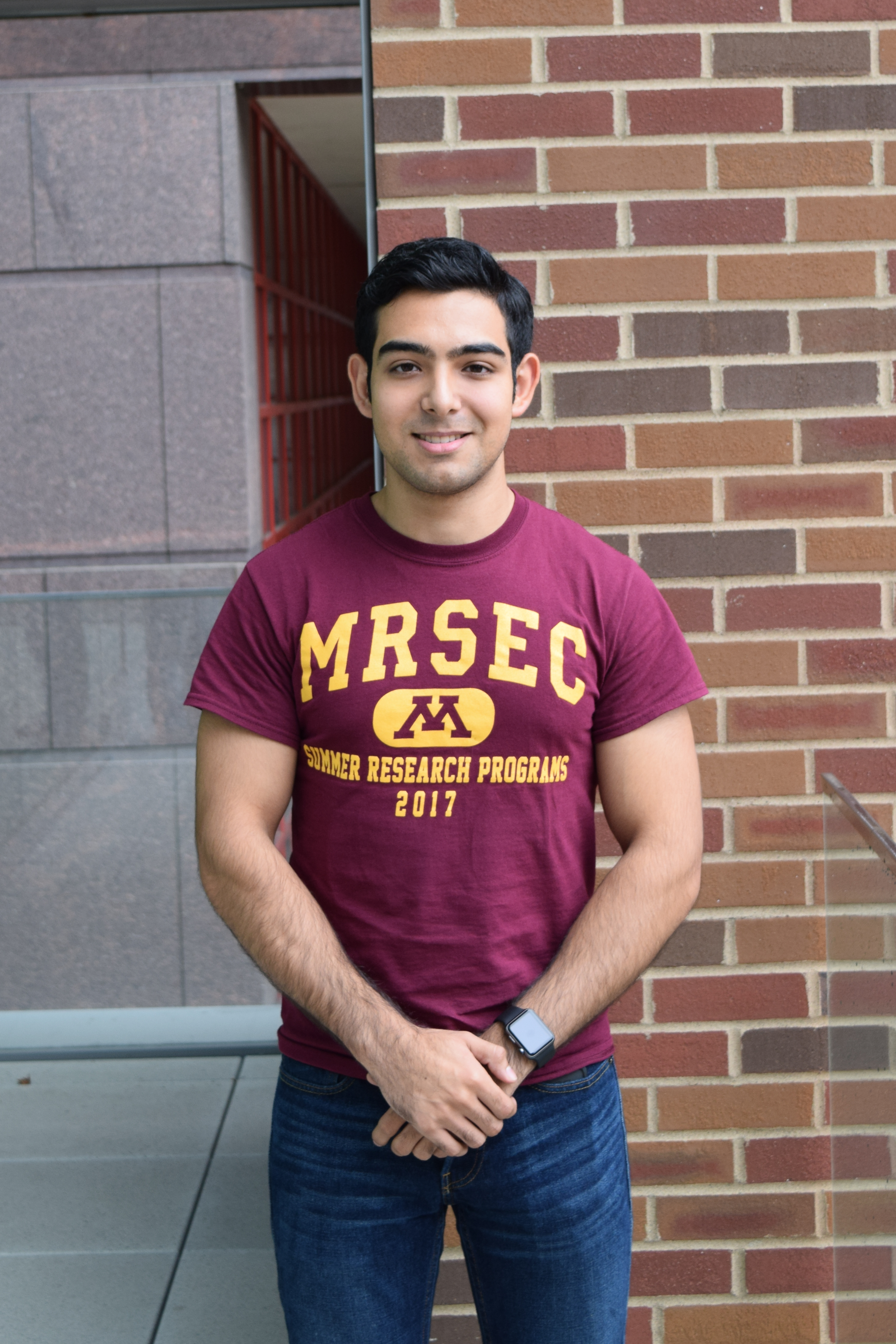
Home Institution: University of Texas Rio Grande Valley
REU Mentor: Eray Aydil
Chemical Composition Analysis of Ligands bound to CdSe Quantum Dots before and after Ligand Exchange
Quantum Dots (QDs) have drawn attention due to their variety of potential applications. QDs are remarkably unique in that they feature the ability to efficiently convert energy into light of nearly any color in the visible spectrum by tuning the QD diameter. To further understand the particular behavior of QD, Cadmium Selenide (CdSe) nanocrystals will be synthesized by reacting a mixture of precursors via Schlenk line, resulting in QD nucleation and growth. When the desired size of nanoparticles is reached, the reaction is quickly terminated by quenching the temperature. The resulting QDs are stabilized in solution by trioctylphosphine oxide (TOPO), trioctylphosphine (TOP), and octadecylphosphonic acid (ODPA), which serve as ligands on the QD surface. To demonstrate the effect that reaction time of TOPSe in the solution has on QD size, a series of syntheses will be performed where the reaction time will be altered. To test the effect of ligands on QD stability in solution, the ratio of ligand chemicals (TOPO, ODPA, and TOP) will be adjusted. In addition, ligand exchange, or the replacement of some TOPO ligands for Polyethylene Glycol (PEG), will be assessed to disperse the nanocrystals in more polar solvents, such as chloroform. Furthermore, QDs was analyzed via Ultraviolet–visible spectroscopy (UV-Vis) to determine their respective absorption peaks and size distributions. Dynamic Light Scattering (DLS) was used to determine aggregation of nanoparticles in various solvents and observe changes upon ligand exchange. Fourier Transform Infrared Spectroscopy (FTIR) was used determine the ligand coverage on the QDs before and after ligand exchange.
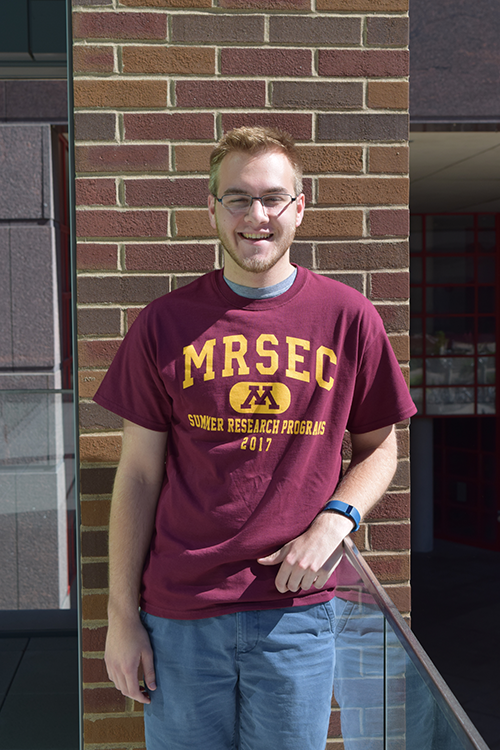
Home Institution: Saint John's University
REU Mentor: Steve Koester
Characterization of Thin-Film Beta-Ga2O3 Using Raman spectroscopy
Thin-layered semiconductors are of importance since they exhibit useful properties which are absent in their bulk counterparts such as photoluminescence, tunable band gap, or increased electron mobility. These properties can provide enhancements to current electronic and optoelectronic devices such as transistors and photodetectors. Their two-dimensional size provides an avenue for smaller functioning devices and greater energy efficiency. Gallium oxide is a semiconductor which has a monoclinic structure and can be separated along its (100) cleavage plane. It also possesses a high energy band gap of 4.9 eV. These properties allow it to be implemented in thinner and higher power electronic devices. We attempted to create monolayer Gallium oxide through mechanical exfoliation techniques and observed the corresponding Raman spectra. Monolayer thicknesses have been successfully identified in Transition metal dichalcogenide (TMDC) semiconductors by observing frequency shifts in their Raman spectra. Therefore, the spectra of two TMDC semiconductors, Molybdenum disulfide and Tungsten ditelluride, were gathered for comparison with Gallium oxide.
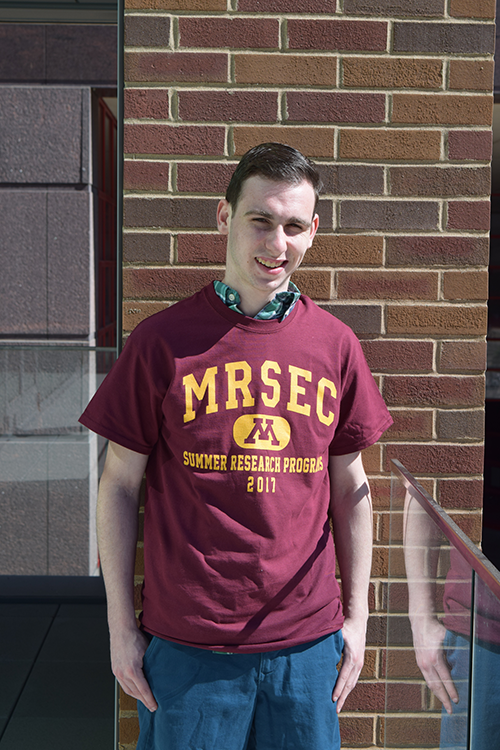
Home Institution: University of Delaware
REU Mentor: Paul Dauenhauer
Verification of an Automatic Microcatalytic Reactor’s Accuracy Using Solid Acid Catalysts
While industrial laboratories own expensive equipment to test catalyst activities over a wide range of conditions, catalyst screening in academic environments can be a tedious process that takes ample time and effort using traditional flow reactors. To solve this problem, a new reactor has been designed for rapid catalyst screening, solely within a gas chromatograph (GC). The new reactor is contained within a gas chromatograph quartz liner and is a semi-continuous flow reactor. It can quickly achieve steady state, where a sample is taken and then a new condition can be set. The validity of the reactor was tested by studying alcohol dehydrations, a common and well documented reaction, and the results were compared with known experimental data. Alcohol dehydration involves the reaction of an alcohol to form either an alkene or ether and water. The catalysts of interest are solid acid catalysts, which include industrial zeolite catalysts such as ZSM-5 and H-BEA. The results were analyzed using gas chromatography and mass spectroscopy, and then compared to data found from scientific literature. More data needs to be collected, but we anticipate that the reactor will be successful, and that it will revolutionize the way data is collected from catalysis, making it a more affordable and efficient process.

Home Institution: University of Texas Rio Grande Valley
REU Mentor: Theresa Reineke
Synthesis of Poly(N-(2-(diethylamino) ethyl) acrylamide) for Cell Transfection.
Poly(N-(2-(diethylamino) ethyl) acrylamide) is a novel water-soluble cationic polymer which exhibits thermo-responsive properties. We hypothesize that this polymer can form polyplexes with DNA that can be used to transfect cells. If the polymer crosses its LCST during transfection, the resulting destabilization of polyplexes may lead to efficient in vitro gene delivery.
The monomer N-(2-(diethylamino) ethyl) acrylamide (DEAEAM) was synthesized according to a literature protocol. Solvent extraction and column chromatography was used to purify it. 1H and 13C NMR as well as IR spectra validated the successful synthesis. Subsequently, polymerization of the monomer was performed using RAFT (Reversible Addition Fragmentation chain Transfer) polymerization to finally obtain three polymers (A, B, and C) with different molecular weights. The final product was dialyzed and freeze dried to obtain the pure material. Several characterization techniques such as Gel Permeation Chromatography (GPC) and 1H NMR were performed to determine the molecular weights of the polymers. Lower Critical Solution Temperature (LCST) which, as its name states, determine the critical temperature at which the material is miscible, was determined as well. The pKa values were measure by potentiometric titrations and found to be 9.25 for the monomer and 8.47 for the polymer, indicating therefore that these two are highly charged at physiological pH. The polymer’s ability to form complexes with DNA was analyzed using Dynamic Light Scattering (DLS), and a gel electrophoresis retention assay, which indicated that starting at N/P ratio of 2.0, binding between polymer and DNA was effective. Finally, the transfection efficiency of the polymer in HeLa cells was analyzed using a green fluorescent protein (GFP) reporter assay analyzed by flow cytometry. Toxicity of the polyplexes was assessed by propidium iodide staining quantified by flow cytometry. The acrylamide polymer based polyplexes showed efficient cellular internalization and low toxicity at low N/Ps. However, efficient delivery of the DNA to the nucleus require further optimizations.
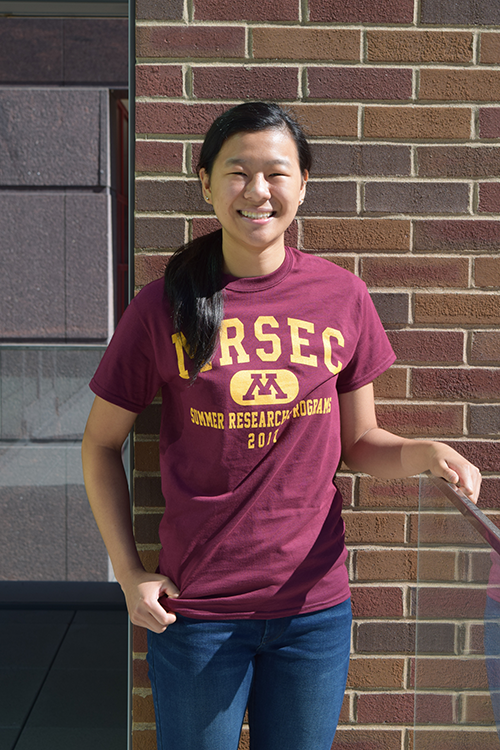
Home Institution: The University of Texas Austin
REU Mentor: Mahesh Mahanthappa
Investigating the Micellar Liquid Crystal Phases of Hydrated Nonionic Surfactants
Surfactants – amphiphilic molecules consisting of a hydrophilic headgroup and hydrophobic tail – form lyotropic liquid crystal phases upon the addition of water. In their liquid crystalline state, these materials have the potential to serve as water desalination membranes, polymer electrolytes in Li-ion batteries, and drug delivery vehicles. However, to effectively design these soft materials for technologically important applications, we must better understand how various factors govern the phase behavior in these systems. Micellar phases have been reported in detail for both polymer and ionic surfactant systems, but studies on nonionic surfactants are largely outdated with general or tentative phase assignments. Thus, using Polarized Light Microscopy and modern Small Angle X-Ray Scattering techniques, we investigated the micellar phases upon hydration of two nonionic surfactants: Brij 58 and C12E10. In Brij 58, we report the formation of BCC, FCC, and the Frank-Kasper phase A15. When heated and cooled back down, the phases seem to evolve in curious ways. In C12E10, we report the formation of a less common HCP phase as well as some interesting, more complex phases upon cooling to near 0 °C temperatures. Our findings suggest that there may be additional Frank-Kasper or more complex phases lurking in our systems, setting the stage for further studies on how and why such phases form.

School: White Bear Lake High School
Mentor: Jane Wissinger
Sustainable Chemistry for High School Classrooms
In chemistry classrooms around the world, some educators have re-designed their labs and demonstrations to be greener and safer. They are training tomorrow’s chemists using the principles of green chemistry. In order to extend these approaches we offered a three day workshop on green and sustainable chemistry for high school teachers. Nineteen participating teachers from Minnesota received instruction on the principles of green chemistry, industrial applications, and potential impacts to human health and the environment. Participants gained hands-on experience with safer, cost-effective labs that minimize waste and are drop-in replacements for traditional secondary chemistry labs. Topics such as bioplastics, polymeric medical sutures and biomimicry were explored demonstrating relevance to societal needs. Following the workshop, an experiment that explores the synthesis of bioplastics and the rates of their degradation was developed for a high school audience to address the need for green chemistry curricula that align with standards and support inquiry based-learning.

School: Red Wing High School
Mentor: Christy Haynes
Dystopian Literature Enhancing Student Engagement in Chemistry
Cross-curricular teaching has been suggested as a potential solution to increase student engagement across several disciplines. Cross-curriculum teaching is an approach to teaching that requires a conscious effort to apply knowledge and principles to more than one academic discipline simultaneously. According to the Minnesota Department of Education, 21.3% of students did not meet reading standards and 18.8% only partially met reading standards in 2016. Despite this, there are still limited efforts to combat these statistics in high school science classrooms. One way to combat this is by introducing dystopian literature into the classroom, which offers students an opportunity to develop their English and language arts skills, while simultaneously learning chemistry concepts. Reading dystopian literature is also a popular teen leisure activity that can help students better connect with the cross-curricular lessons and better retain chemistry content. These lessons focused on the dystopian literature Divergent and were developed for the 2017-2018 academic year for general chemistry high school students. These lessons introduced students to microfluidics and were intended to promote critical reasoning skills, engineering and designing, reading comprehension, and application of chemistry concepts to dystopian literature. These lessons were designed to challenge students to see chemistry in activities outside of academia, such as movies and literature.

School: Saint Paul Public Schools
Mentor: Ben Hackel
Teaching About Enzymes in High School Chemistry
Enzymes are a topic covered in the biochemistry unit of most higher level (AP, IB, Advanced) and some general level high school chemistry classes. It is typical to have students complete lab work look at how enzymes interact with proteins specifically how enzymes work to degrade proteins. However, enzymes also interact with lipids and carbohydrates. Because enzymes only interact with specific substrates, one enzyme will not interact with proteins, lipids and carbohydrates. This lab can be used to teach students about the selectivity of enzymes for different substrates and has the possibility to teach about kinetics using colorimetry.
UMN MRSEC
435 Amundson Hall, 421 Washington Ave. SE, Minneapolis, MN, 55455
P: 612-626-0713 | F: 612-626-7805